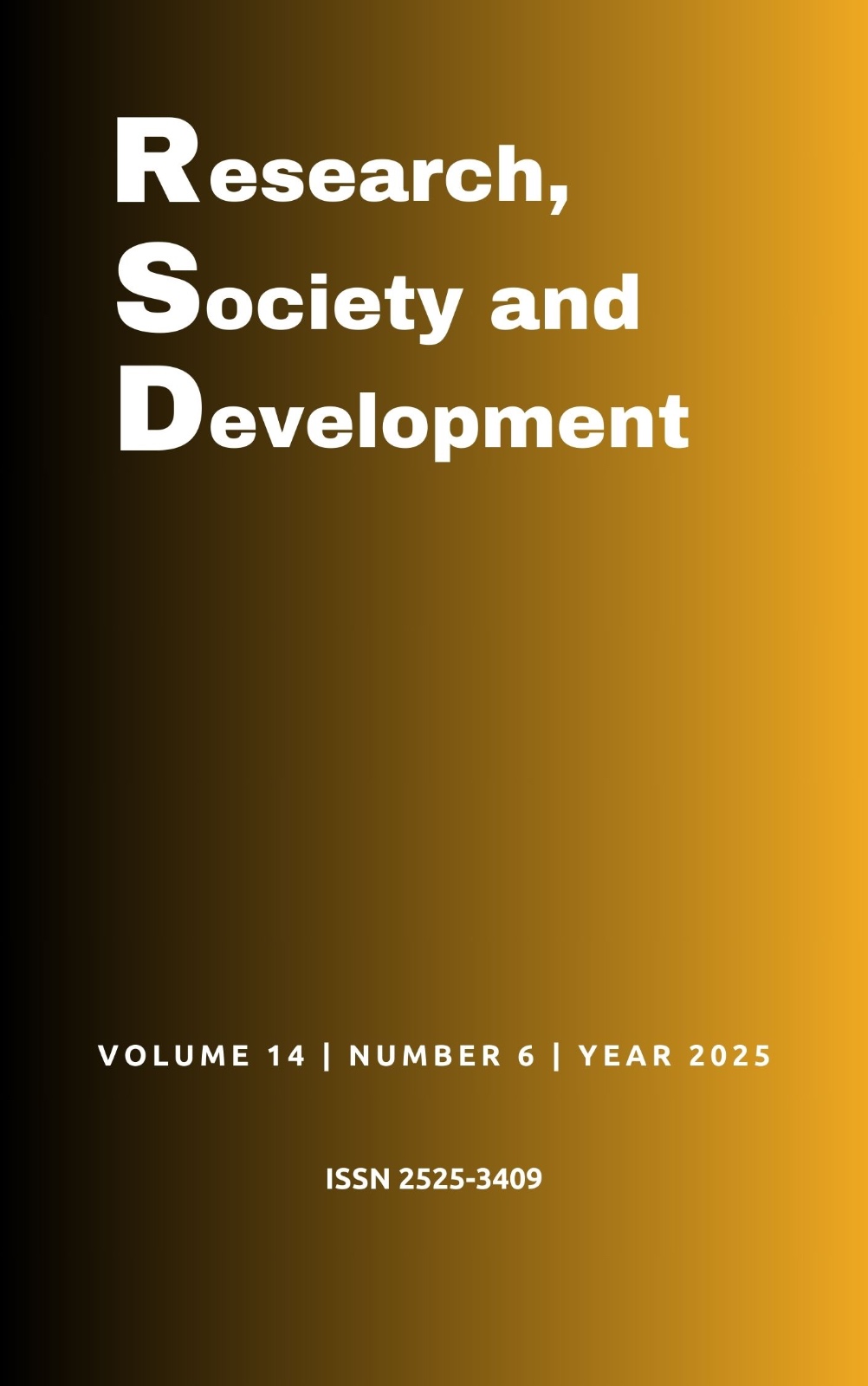Application of machine learning techniques in the predictability of the revenue of the Financial Compensation for Mineral Exploitation (CFEM): A case study in the Municipality of Parauapebas, State of Pará (PA), Brazil
DOI:
https://doi.org/10.33448/rsd-v14i6.48913Keywords:
CFEM, Revenue forecasting, Mining, Parauapebas, Machine learning.Abstract
This article aims to apply supervised machine learning models, specifically the Random Forest Regressor and K-Nearest Neighbors (KNN) algorithms, to predict the revenue collected by the Financial Compensation for Mineral Exploitation (CFEM) in the Municipality of Parauapebas, State of Pará (PA), Brazil. This article presents an application of machine learning models to forecast CFEM revenue, focusing on the municipality of Parauapebas. The research is characterized as applied, quantitative, and descriptive, using supervised regression algorithms — Random Forest and K-Nearest Neighbors — applied to public data from the National Mining Agency (ANM), from 2015 to 2024. The results showed that the Random Forest model had the best predictive performance compared to KNN, achieving a coefficient of determination (R²) above 0.90. The forecast for January 2025 indicated a revenue exceeding BRL 100 million, highlighting the potential of predictive modeling to support municipal budget planning. It is concluded that artificial intelligence techniques can significantly contribute to public management in mining municipalities, especially in scenarios with high dependence on CFEM revenues.
Downloads
References
Agência Nacional de Mineração. (2024). Sistema de arrecadação da CFEM. https://www.gov.br/anm
Bishop, C. M. (2006). Pattern recognition and machine learning. Springer.
Farias, R., Oliveira, M., & Silva, J. (2022). Previsão de receitas públicas com técnicas de inteligência artificial. Revista de Administração Pública, 56(3), 233–250. https://doi.org/10.1590/0034-761220210100
Géron, A. (2019). Hands-on machine learning with Scikit-Learn, Keras, and TensorFlow (2nd ed.). O’Reilly Media.
Goodfellow, I., Bengio, Y., & Courville, A. (2016). Deep learning. MIT Press.
Han, J., Kamber, M., & Pei, J. (2012). Data mining: Concepts and techniques (3rd ed.). Elsevier.
Instituto Brasileiro de Geografia e Estatística. (2023). Estimativas populacionais para os municípios brasileiros. https://www.ibge.gov.br
Kotsiantis, S. B. (2013). Decision trees: A recent overview. Artificial Intelligence Review, 39(4), 261–283. https://doi.org/10.1007/s10462-011-9272-4
Kuhn, M., & Johnson, K. (2013). Applied predictive modeling. Springer. https://doi.org/10.1007/978-1-4614-6849-3
Li, B., Hou, B., Yu, W., Lu, X., & Yang, C. (2017). Applications of artificial intelligence in intelligent manufacturing: A review. Frontiers of Information Technology & Electronic Engineering, 18(1), 86–96. https://doi.org/10.1631/FITEE.1601885
Lundberg, S. M., & Lee, S. I. (2017). A unified approach to interpreting model predictions. Advances in Neural Information Processing Systems, 30, 4765–4774. https://proceedings.neurips.cc/paper/2017/file/8a20a8621978632d76c43dfd28b67767-Paper.pdf
Organisation for Economic Co-operation and Development. (2023). Revenue statistics in Latin America and the Caribbean 2023. https://www.oecd.org
Pedregosa, F., Varoquaux, G., Gramfort, A., Michel, V., Thirion, B., Grisel, O., ... & Duchesnay, É. (2011). Scikit-learn: Machine learning in Python. Journal of Machine Learning Research, 12, 2825–2830.
Pereira, A. S., Shitsuka, D. M., Parreira, F. J., & Shitsuka, R. (2018). Metodologia da pesquisa científica (e-book gratuito). Santa Maria/RS: Ed. UAB/NTE/UFSM. https://repositorio.ufsm.br/bitstream/handle/1/15824/Lic_Computacao_Metodologia-Pesquisa-Cientifica.pdf
Raschka, S., & Mirjalili, V. (2020). Python machine learning: Machine learning and deep learning with Python, Scikit-learn, and TensorFlow 2 (3rd ed.). Packt Publishing.
Ribeiro, M. T., Singh, S., & Guestrin, C. (2016). “Why should I trust you?”: Explaining the predictions of any classifier. In Proceedings of the 22nd ACM SIGKDD International Conference on Knowledge Discovery and Data Mining (pp. 1135–1144). https://doi.org/10.1145/2939672.2939778
Shrivastava, A., Pandey, A., & Singh, N. (2024). Artificial intelligence: Evolution, methodologies, and applications. International Journal for Research in Applied Science and Engineering Technology, 12(4), 1212–1221. https://doi.org/10.22214/ijraset.2024.01234
Silva, D. P., & Souza, H. R. (2023). O uso de dados abertos para planejamento público: Estudo de caso em municípios mineradores. Revista Gestão Pública e Cidadania, 28(2), 134–152. https://doi.org/10.12660/rgpc.v28n2.2023.89123
Souza, R. M., & Costa, E. M. (2021). Aplicações de aprendizado de máquina em finanças públicas: Uma revisão sistemática. Revista Brasileira de Computação Aplicada, 13(2), 45–62. https://doi.org/10.5935/2238-1031.20210006
World Bank. (2023). Natural resources governance: Fiscal tools and revenue management. https://www.worldbank.org
Yin, R. K. (2015). O estudo de caso. Porto Alegre: Bookman.
Zhou, Z.-H. (2021). Machine learning (2nd ed.). Springer. https://doi.org/10.1007/978-981-15-5987-4
Downloads
Published
Issue
Section
License
Copyright (c) 2025 Keny Lucas da Silva Goes; Kaua Chrystian da Silva Goes

This work is licensed under a Creative Commons Attribution 4.0 International License.
Authors who publish with this journal agree to the following terms:
1) Authors retain copyright and grant the journal right of first publication with the work simultaneously licensed under a Creative Commons Attribution License that allows others to share the work with an acknowledgement of the work's authorship and initial publication in this journal.
2) Authors are able to enter into separate, additional contractual arrangements for the non-exclusive distribution of the journal's published version of the work (e.g., post it to an institutional repository or publish it in a book), with an acknowledgement of its initial publication in this journal.
3) Authors are permitted and encouraged to post their work online (e.g., in institutional repositories or on their website) prior to and during the submission process, as it can lead to productive exchanges, as well as earlier and greater citation of published work.


